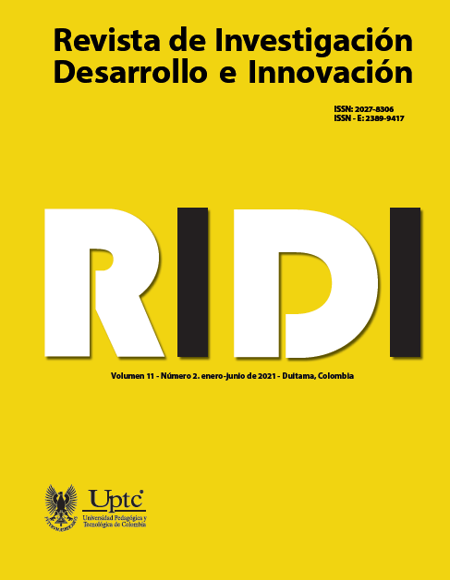Biodegradación de policloruro de vinilo por Mucor s.p. y Penicillium s.p. aislados de suelo

Resumen
El PVC es uno de los plásticos más usados y de los que más residuos se producen. En los últimos años, se han reportado microorganismos capaces de degradarlo y que en su mayoría provienen de ambientes en los que se acumula. El objetivo de este trabajo fue estudiar la degradación del PVC sin plastificante, a partir de hongos aislados de una muestra de suelo contaminada con resina de PVC. Los hongos se aislaron y caracterizaron morfológicamente, obteniendo 30 aislamientos de los que se escogieron 8 para someterlos a pruebas preliminares, en un medio cuya única fuente de carbono era una película de PVC. Se hicieron curvas de crecimiento de los dos aislamientos con mejores resultados, y su identificación molecular mostró que correspondían a Penicillium sp. y Mucor sp.. Este último ganó biomasa a partir del PVC y en los dos casos, las películas mostraron cambios visibles, que fueron respaldados por espectros de infrarrojo. Aunque los resultados mostrados en este artículo son preliminares, abren la puerta a nuevas formas de degradación de los residuos de PVC, que son muy persistentes.
Palabras clave
Penicillium expansum;, Mucor sp;, PVC;, aislamientos fúngicos;, curvas de crecimiento
Biografía del autor/a
María Luisa Pardo-Rodríguez
Environmental Engineering Student
Patricia Joyce Pamela Zorro-Mateus
Chemist, Msc. In Biochemistry
Citas
Acoplásticos. (2019). Plásticos en Colombia 2019-2020. In Plásticos en Colombia 2019-2020 (49th ed.,126).
Ali, M. I., Ahmed, S., Robson, G., Javed, I., Ali, N., Atiq, N., & Hameed, A. (2014). Isolation and molecular characterization of polyvinyl chloride (PVC) plastic degrading fungal isolates. Journal of Basic Microbiology, 54(1), 18–27. https://doi.org/10.1002/jobm.201200496
Barnett, H., & Hunter, B. (1972). Illustrated genera of imperfect fungi (Third). Minneapolis: Burgess Publishing Company.
Bergmann, M., Mützel, S., Primpke, S., Tekman, M. B., Trachsel, J., & Gerdts, G. (2019). White and wonderful? Microplastics prevail in snow from the Alps to the Arctic. Science Advances, 5(8), 1–10. https://doi.org/10.1126/sciadv.aax1157
De Campos, A., & Martins Franchetti, S. M. (2005). Biotreatment effects in films and blends of PVC/PCL previously treated with heat. Brazilian Archives of Biology and Technology, 48(2), 235–243. https://doi.org/10.1590/s1516-89132005000200010
Domsch, K. Gams, W. & Anderson, T. (1980) Compendium of soil fungi, 1, Academic Press London Ltd. London, United Kingdom.
Felsentein, J. (1985). Confidence limits on phylogenies: An approach using the bootstrap. Evolution, 39 (4), 783–791. https://doi.org/10.2307/2408678
Giacomucci, L., Raddadi, N., Soccio, M., Lotti, N., & Fava, F. (2020). Biodegradation of polyvinyl chloride plastic films by enriched anaerobic marine consortia. Marine Environmental Research, 158. https://doi.org/10.1016/j.marenvres.2020.104949
Grisa, A. M. C., Simioni, T., Cardoso, V., Zeni, M., Brandalise, R. N., & Zoppas, B. C. D. A. (2011). Degradação biológica do PVC em aterro sanitário e avaliação microbiológica. Polimeros, 21(3), 210–216. https://doi.org/10.1590/S0104-14282011005000046
Gu, J.-D. (2003). Microbiological deterioration and degradation of synthetic polymeric materials: Recent research advances. International Biodeterioration and Biodegradation, 52, 69–91. https://doi.org/10.1016/S0964-8305(02)00177-4
Hamzah, A., Manikan, V., & Abd Aziz, N. A. F. (2017). Biodegradation of tapis crude oil using consortium of bacteria and fungi: Optimization of crude oil concentration and duration of incubation by response surface methodology. Sains Malaysiana, 46(1), 43–50. https://doi.org/10.17576/jsm-2017-4601-06
Harms, H., Schlosser, D., & Wick, L. Y. (2011). Untapped potential: exploiting fungi in bioremediation of hazardous chemicals. Nature Reviews Microbiology, 9, 177. http://dx.doi.org/10.1038/nrmicro2519
Kaczmarek, H., & Bajer, K. (2007). Biodegradation of Plasticized Poly (Vinyl Chloride) Containing Cellulose. Journal of Polymer Science, 45, 903–919. https://doi.org/10.1002/polb
Klrbas, Z., Keskin, N., & Güner, A. (1999). Biodegradation of Polyvinylchloride (PVC) by White Rot Fungi. Bull. Environ. Contam. Toxicol, 63, 335–342. https://doi.org/10.1007/s001289900985
Kimura, M. (1980). A simple method for estimating evolutionary rates of base substitutions through comparative studies of nucleotide sequences. Journal of Molecular Evolution, 16(2), 111–120. https://doi.org/10.1007/BF01731581
Kumar, S., Stecher, G., Li, M., Knyaz, C., & Tamura, K. (2018). MEGA X: Molecular evolutionary genetics analysis across computing platforms. Molecular Biology and Evolution, 35 (6), 1547–1549. https://doi.org/10.1093/molbev/msy096
Lucas, N., Bienaime, C., Belloy, C., Queneudec, M., Silvestre, F., & Nava-Saucedo, J. E. (2008). Polymer biodegradation: Mechanisms and estimation techniques - A review. Chemosphere, 73(4), 429–442. https://doi.org/10.1016/j.chemosphere.2008.06.064
Pacasa-quisbert, F., Loza-murguia, M., Bonifacio-flores, A., Vino-nina, L., & Serrano-canaviri, T. (2017). Comunidad de hongos filamentosos en suelos del Agroecosistema de K’iphak’iphani, Comunidad Choquenaira-Viacha. Selva Andina Research Society, 8 (1), 2–25. http://www.scielo.org.bo/scielo.php?script=sci_arttext&pid=S2072-92942017000100002
Park, E. J., Park, B. C., Kim, Y. J., Canlier, A., & Hwang, T. S. (2018). Elimination and substitution compete during amination of poly(vinyl chloride) with ehtylenediamine: XPS analysis and approach of active site index. Macromolecular Research, 26 (10), 913–923. https://doi.org/10.1007/s13233-018-6123-z
Raddadi, N., & Fava, F. (2019). Biodegradation of oil-based plastics in the environment: Existing knowledge and needs of research and innovation. Science of the Total Environment, 679, 148–158. https://doi.org/10.1016/j.scitotenv.2019.04.419
Sánchez, C. (2020). Fungal potential for the degradation of petroleum-based polymers: An overview of macro- and microplastics biodegradation. Biotechnology Advances, 40. https://doi.org/10.1016/j.biotechadv.2019.107501
Sumathi, T., Viswanath, B., Lakshmi, A. S., & Saigopal, D. V. R. (2016). Production of laccase by Cochliobolus sp. Isolated low molecular weight PVC. Biochemistry Research International, 2016, 1–10. https://doi.org/http://dx.doi.org/10.1155/2016/9519527
Vivi, V. K., Martins-Franchetti, S. M., & Attili-Angelis, D. (2019). Biodegradation of PCL and PVC: Chaetomium globosum (ATCC 16021) activity. Folia Microbiologica, 64, 1-7. https://doi.org/10.1007/s12223-018-0621-4
Vrabl, P., Schinagl, C. W., Artmann, D. J., Heiss, B., & Burgstaller, W. (2019). Fungal Growth in Batch Culture – What We Could Benefit If We Start Looking Closer. Frontiers in Microbiology, 10(October), 1–11. https://doi.org/10.3389/fmicb.2019.02391
Webb, J. S., Nixon, M., Eastwood, I. M., Greenhalgh, M., Robson, G. D., & Handley, P. S. (2000). Fungal colonization and biodeterioration of plasticized polyvinyl chloride. Applied and Environmental Microbiology, 66(8), 3194–3200. https://doi.org/10.1128/AEM.66.8.3194-3200.2000
White, T., Burns, T., Lee, S., & Taylor, J. (1990). Amplification and direct sequencing of fungal ribosomal RNA genes for phylogenetics. In D. H. Gelfand, J. J. Sninsky, & T. J. White (Eds.), PCR protocols. A guide to methods and applications 18, 315–322). San Diego, Calif.: Academic Press Inc.
